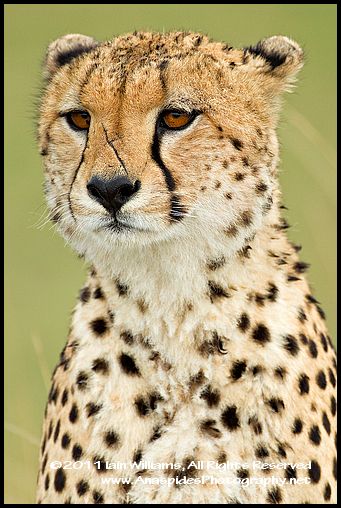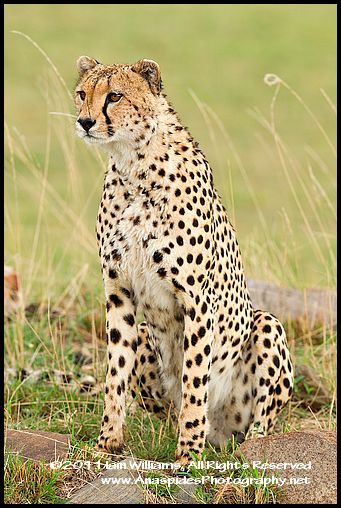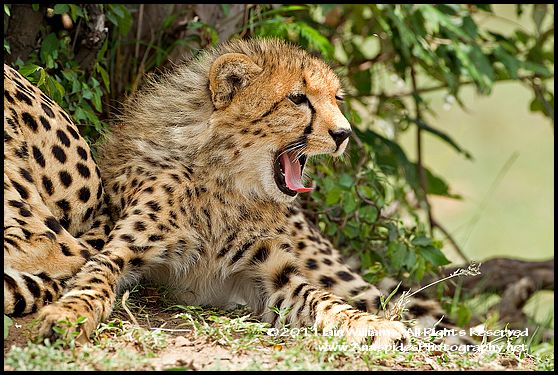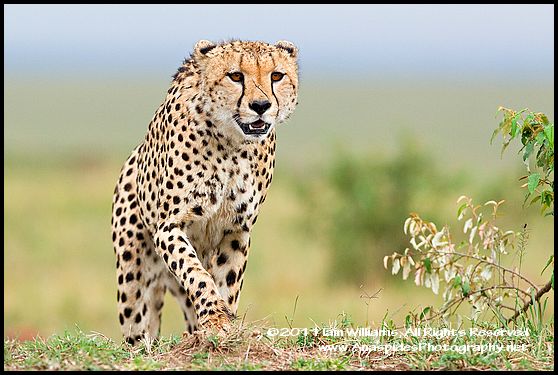 The Hunt
The Hunt
The following morning, whilst travelling the usual rough route from the camp to the last known position of the cheetahs, our luck appeared to change. The brothers were on the move and tailing a large herd of wildebeest. Quickly driving to a suitable shooting position in relation to the sun, we prepared our cameras for what was hoped would be a kill.
LEFT: A cheetah moves out from the cover of the stream and makes his way toward the herd.
One of cheetahs climbed a termite mound, to see further ahead, before setting off at a fast trot moving toward our vehicle. In an instant, the feline was transformed from a sleeping house cat to a highly mobile 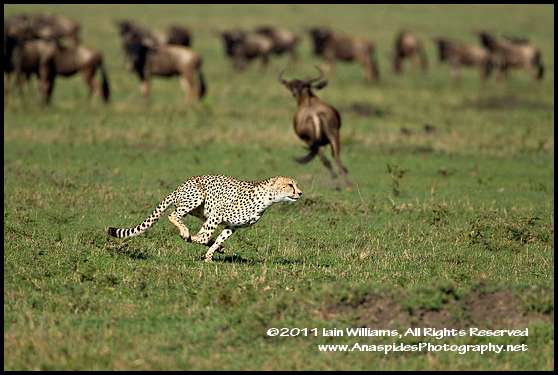 killing machine. It was so fast, almost a blur, as the cat shortened its distance between itself and the herd of wildebeest. The target was a largish individual, enough to sustain the three hunters. But where were the other hunters – only one was chasing the target prey. The other two hunters were lolling behind enjoying the morning sun while playing in the grass!
killing machine. It was so fast, almost a blur, as the cat shortened its distance between itself and the herd of wildebeest. The target was a largish individual, enough to sustain the three hunters. But where were the other hunters – only one was chasing the target prey. The other two hunters were lolling behind enjoying the morning sun while playing in the grass!
LEFT: A male cheetah, bypasses a fleeing wildebeest as it locks onto an individual within the herd.
Confrontation
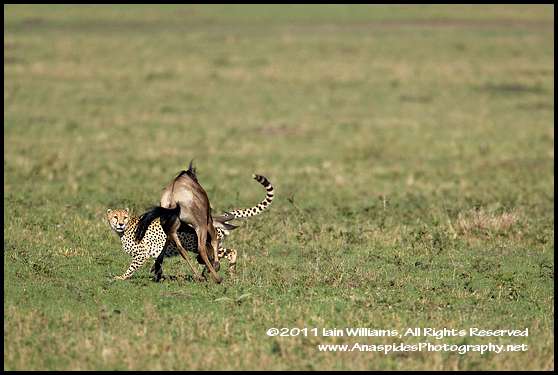 The wildebeest, perhaps sensing an untrained solo hunter, stopped running and turned while lowered its head to confront the cheetah. A brief exchange took place whereby the wildebeest charged the cheetah attempting to injure the adolescent with its two flailing front legs and hoofs. The cheetah made a fleeting attempt at grabbing the rear flank without success before retreating to a safer distance from the aggressive wildebeest.
The wildebeest, perhaps sensing an untrained solo hunter, stopped running and turned while lowered its head to confront the cheetah. A brief exchange took place whereby the wildebeest charged the cheetah attempting to injure the adolescent with its two flailing front legs and hoofs. The cheetah made a fleeting attempt at grabbing the rear flank without success before retreating to a safer distance from the aggressive wildebeest.
LEFT: Adult wildebeest are no easy match for a cheetah. The wildebeest rather than run, stops and confronts the cat.
The hunt had ended and the cheetah was left standing, panting and looking towards his brethren with a disdainful look on his face which clearly said “where were you?” The hunt, run and attack was a failure due to poor cooperation between the trio.
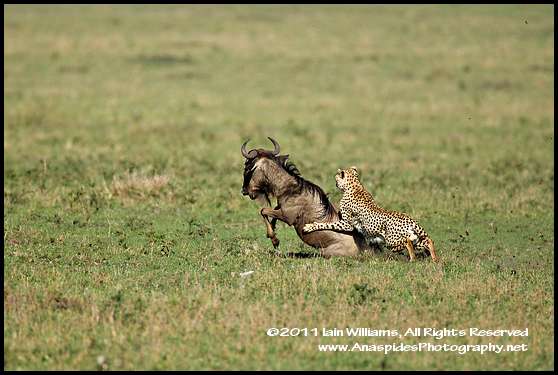 Let’s Try Again…
Let’s Try Again…
A lager (a thin strip of thick vegetation that hides a watercourse) was directly in front of the moving wildebeest. We decided that the prime shooting position would be with the sun behind us on the quarter at the other side of the lager. To reach this position required us to drive across the rough lager and a small stream.
LEFT: Paws outstretched, a cheetah brings down a wildebeest after a short but very fast run.
Meanwhile, the trio had reunited and were making a steady pace behind the herd. We were certain a kill would happen this morning; the cheetahs were active and we knew they must be hungry!
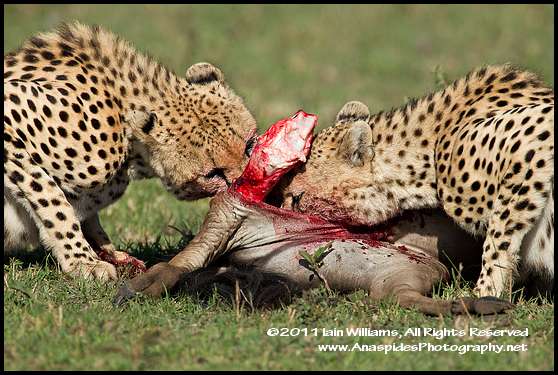 The wildebeest slowly moved around our vehicle; for a moment I was concerned our presence would predetermine the direction of the herd. However, this didn’t occur as the animals abruptly altered direction moving away and to the left of our vehicle. The herd comprised a number of mothers with first born, inexperienced adolescents, and old salts. It’s the young and inexperienced that are usually targeted by predators.
The wildebeest slowly moved around our vehicle; for a moment I was concerned our presence would predetermine the direction of the herd. However, this didn’t occur as the animals abruptly altered direction moving away and to the left of our vehicle. The herd comprised a number of mothers with first born, inexperienced adolescents, and old salts. It’s the young and inexperienced that are usually targeted by predators.
LEFT: The prey is now dead and the cheetahs share the choice pieces of the kill. One cheetah drinks fresh blood from a severed artery whilst another chews on a flank.
The cheetahs, following each other, pushed through the dense vegetation of the lager and stopped short of the savannah. The cats assessing the situation quickly, realized that the herd was moving towards them. They broke from the cover provided by the lager and began to walk toward the herd maintaining what cover was available from the natural contours of the land. The herd hadn’t noticed the three slick cats, until they bounded from a walk to a very fast run, which became a blur as they shortened the distance to the herd. The wildebeest finally saw the danger and the lead animals broke into a run which translated to a wild frenzy of movement as each individual in the herd panicked. The hunting had ended and the chase had begun.
The Hunting Had Ended & The Chase Had Begun
It was too little too late! The three cats were amongst the herd and it was difficult to think that the hunt would not be a success. At first, each cat appeared to target what he thought was a prime individual, but as they ran along the side the herd, a dedicated target was selected from the many. The three cats, in marvellous co operation ran the ‘chosen one” away from the protection of the central section of the herd. The singled out wildebeest ran fast, weaving and dancing in an attempt to remove the ‘target lock” achieved by the cheetahs. The individual selected was not an inexperienced youngster, but a fully grown adult who was more than capable of outfighting a single cheetah, but what about three cheetahs acting as one unified force?
Feline Cooperation
The first cheetah pawed the rear leg of the wildebeest, but missed!; the resultant inertia forcing him to loose his footing and fall to the ground. The second cat manoeuvred himself to the front of the wildebeest causing the stricken animal to alter direction and loose speed. The third cheetah made his move and with two paws outstretched, fastened himself to the rump of the now highly panicked animal and wrestled him to the ground. Attempting to get a better purchase on the animal, the cheetah released his grip and the wildebeest, realizing his opportunity, jumped from the cheetah’s grasp to make an escape. However, by this time the first cat, recovered from his fall, leapt onto the rear of the animal, bringing him down before he could make good his escape. The cheetah that had lost his initial purchase on the rump, quickly climbed onto the panting wildebeest holding 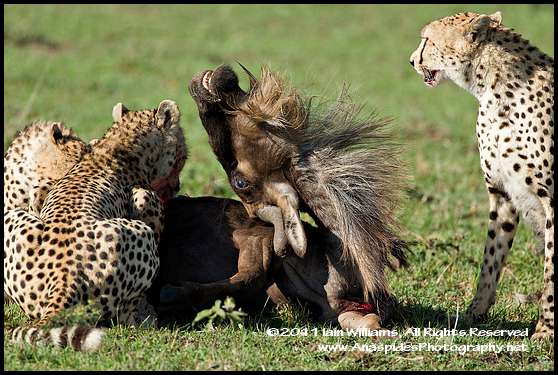 him to the ground. It was over. The death of one would be the life of three.
him to the ground. It was over. The death of one would be the life of three.
The hunt, chase and kill had transpired very quickly. Now there was a stricken wildebeest lying on the ground with two cheetahs beginning to feed, whilst the third kept a careful watch for intruders.
LEFT: Two hungry cheetahs begin to feast on the still live wildebeest whilst a third cheetah watches for other predators. It's unusual behaviour for cheetahs to feed on still-living prey.
While one of the brothers tore the flesh from the favoured area of the animal; the rear haunches, his brethren began to open an area in the region of the neck, to drink the fresh blood. Blood is very rich in iron and often is drunk by animals as a vitamin supplement to water. The luckless victim continued to try and make an escape, but clearly this movement was instinctive. I was told by the KWS ranger that cheetahs rarely eat live food, and to do so, probably can be explained by heightened hunger.
In between feeding, each cheetah in unison would stop momentarily, raise himself high from the ground and scan the horizon for danger. A lion or hyena group could easily steal the carcass and perhaps injure one of the trio. Overhead, vultures attracted to the recent kill, began to circle the carcass.
Unusual Cheetah Behaviour
The normal practice for cheetahs is to “rush their meal” for fear of losing it to another scavenging animal – the behaviour is almost “hit and run”; but, thirty minutes had gone by and the three brothers were still eating! This was not normal behaviour.
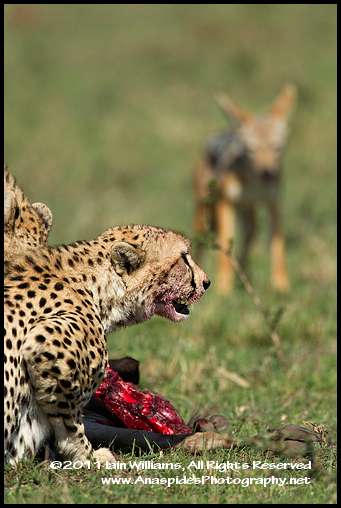 The flanks had been consumed and now the trio were demolishing and feeding upon the remainder of the carcass. A lone jackal, attracted by the smell of blood boldly made his way towards the carcass, however, the brothers had little intension of sharing their food with a non family member and quickly charged the jackal, putting this “lower predator” into its rightful place. Eventually the jackal was successful in steeling a morsel (the stomach).
The flanks had been consumed and now the trio were demolishing and feeding upon the remainder of the carcass. A lone jackal, attracted by the smell of blood boldly made his way towards the carcass, however, the brothers had little intension of sharing their food with a non family member and quickly charged the jackal, putting this “lower predator” into its rightful place. Eventually the jackal was successful in steeling a morsel (the stomach).
LEFT: A male cheetah lifts its head from early dining to sneer at a Jackrel that wants her share of the free food which the jackrel did not earn....
The three brothers, whose bellies were now visibly distended, had within forty minutes consumed most of the accessible meat from the carcass. Immediately after the last cheetah had left the remains, the waiting vultures descended and began to rip apart the remainder of the flesh. The transition was swift; it reminded me of a hoard of flies attracted to a piece of left over meat at a summer BBQ, or perhaps a school of piranha attacking a hapless victim in Amazonian waters. Literally within minutes, the bones were picked relatively clean with only the rib cage showing above the grass. Nothing went to waste.
Cheetah Cubs
I'll return to the cheetahs at some stage in the future, however, I won't be discussing the three brothers. Instead, we'll have a glimpse into the life of three, very playful one-week old cheetah cubs and their mother.
 Friday, August 10, 2012 at 9:29AM
Friday, August 10, 2012 at 9:29AM 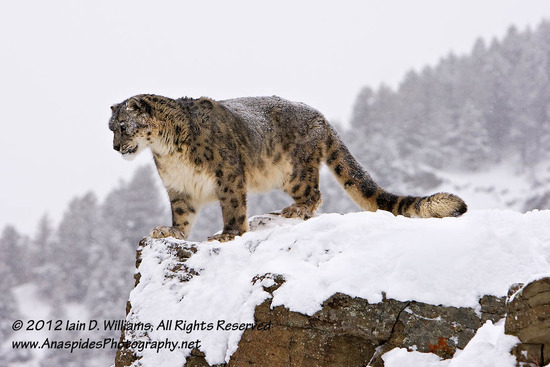 Most readers have seen pictures of leopards living in Africa, often seen in the branches of trees resting in the hot midday sun. Likewise, most people have seen the black panther; actually a leopard that has a gene for black fur, whose major habitat is upper south America. The snow leopard (Panthera uncia) is a animal rarely seen yet known outside it's major habitat, which is Central Asia.
Most readers have seen pictures of leopards living in Africa, often seen in the branches of trees resting in the hot midday sun. Likewise, most people have seen the black panther; actually a leopard that has a gene for black fur, whose major habitat is upper south America. The snow leopard (Panthera uncia) is a animal rarely seen yet known outside it's major habitat, which is Central Asia. 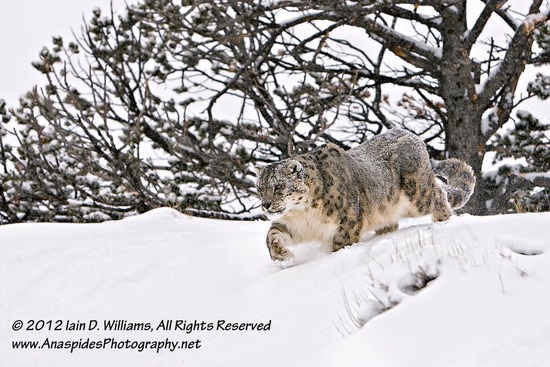 mountainous environment. Their bodies are stocky, their fur is thick, and their ears are small and rounded, all of which help to minimise heat loss. Their feet are wide, which distributes their weight better for walking on snow, and they have fur on their undersides to increase their traction on steep and unstable surfaces, as well as to assist with minimizing heat loss. Snow leopards' tails are long and flexible, helping them to maintain their balance. The tails are also very thickly covered with fur which, apart from minimizing heat loss, allows them to be used like a blanket to protect their faces when asleep.
mountainous environment. Their bodies are stocky, their fur is thick, and their ears are small and rounded, all of which help to minimise heat loss. Their feet are wide, which distributes their weight better for walking on snow, and they have fur on their undersides to increase their traction on steep and unstable surfaces, as well as to assist with minimizing heat loss. Snow leopards' tails are long and flexible, helping them to maintain their balance. The tails are also very thickly covered with fur which, apart from minimizing heat loss, allows them to be used like a blanket to protect their faces when asleep.









